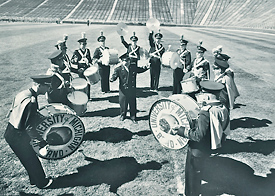History is the foundation of the university’s excellence, leadership and diversity, and it is celebrated like never before through the new U-M Heritage Project website, launched today at heritage.umich.edu.
The coming 2017 U-M bicentennial inspired the website. Powerful images and stories bring the university’s history and triumphs to life, and the diverse people behind them.

William D. Revelli, the innovative director of bands, leads the U-M Band drum section in a 1954 rehearsal. His story is among several presented on the new U-M Heritage Project website. Photo courtesy Bentley Historical Library.
“The university’s leadership and innovation are emphasized, as is the role of mind and intellect,” says Lisa Rudgers, vice president for global communications and strategic initiatives. “We are introducing the community to some special university people they may not know at all, or not know much about.”
The story of “Aunt” Ruth Bacon Buchanan, a receptionist at the Museum of Natural History, is among the most compelling. During World War II, Buchanan wrote former students and others with U-M ties fighting the war. “She corresponded with more than 2,200 men and women, wrote nearly 18,000 letters, mailed more than 21,000 cards — for birthdays, valentines and holidays. It’s astounding,” says Kim Clarke, director of executive communications and project manager.
“We really want to share dramatic and personal stories that make up the Michigan story — one people will come to know and share,” Clarke says.
Raoul Wallenberg, who saved thousands of Jews during World War II as a Swedish diplomat in Hungary, is remembered as a U-M architecture student. Born to wealth and privilege in Sweden, in Ann Arbor “Rudy” Wallenberg lived in plain boarding houses, sometimes stressed over exams, and hitchhiked around the United States for summer adventure. “There just was no snobbery about him,” a classmate recalled.
Strong images speak to the viewer. Aunt Ruth is revealed as a pleasant, neat woman pictured at a writing table. The tall, trim Wallenberg poses for a photo on the Bear Mountain Bridge in upstate New York. Martin Luther King Jr. engages the Hill Auditorium crowd, from behind the historic lectern donated by the Class of 1913.
“We’re big believers in traditional storytelling, but storytelling gets a boost when people can see images of places and characters,” says James Tobin, an authority on U-M history and project consultant.
The stories run the gamut from unsettling to triumphant. Medical faculty of the 19th century sometimes crossed the bounds of polite society to secure cadavers for anatomical studies, as recounted in “Such Horrible Business.”
“We determined early on that we would not shy away from the more challenging parts of our history, since those chapters so often led to important reform here and elsewhere,” Rudgers says.
The clear eyes of young Alice Hamilton fill the screen. She would become the nation’s leading expert on workplace diseases and the first woman appointed to the Harvard faculty. But when Hamilton arrived in Ann Arbor in 1892 as a student, she wrote home to Ford Wayne, Ind., that she felt like a nobody. Determined to record “some definite achievement, something really lasting … to make the world better,” her professional work would support reforms leading to the Occupational Safety and Health Act of 1970.
Heritage website viewers are greeted by slideshow images. A timeline and five themes are revealed: A Public University, Teacher and Student, Explorations, The Students’ World and A Campus Grows.
Clarke says the Bentley Historical Library’s resources are a key source for the website. The research of Kaitlyn DelBene, an LSA senior studying Italian and English, has been integral to the content, she says.
Tobin says that along with stories of student life, “We also want people to see stories about what you might call adventures of the mind, stories about thinkers and teachers and scientists.”
One such piece is about Yale Kamisar, a U-M law professor known as the “Father of Miranda.” He influenced the U.S. Supreme Court decision that police must tell suspects they’re protected by constitutional guarantees against self-incrimination, and that they have a right to counsel.
The Heritage website launches with 10 feature stories, with 10-12 new narratives planned each year through the bicentennial celebration. The design allows the public to submit comments.
The website is specifically designed for tablets, but is just as adaptable to laptop and desktop computers as well as hand-held devices. The project is supported by the Office of the President, Office of the Vice President for Global Communications, and Bentley Historical Library.

